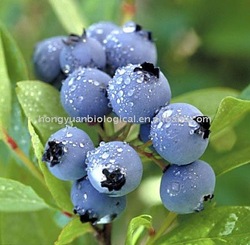BILBERRY (Vaccinium myrtillus L.)

Activities (Bilberry) — Antiaggregant (1; APA; BGB; MAB; PED; PH2); Anticapillary Fragility
(2; BGB; MAB; PED; PH2); Antiedemic (1; BGB; HH2; MAB; PH2); Antiexudative (1; HH2;
PH2); Antiherpetic (f; HH2); Antiinflammatory (1; MAB; PED); Antiischemic (1; MAB; PH2);
Antioxidant (1; FNF; SKY); Antiplaque (1; HH2); Antipyretic (1; PNC); Antiretinohemorrhagic
(1; PH2); Antiseptic (1; APA; FNF; MAD); Antispasmodic (1; PED); Antiulcer (1; APA; MAB;
PH2); Antiviral (1; APA; HH2); Astringent (1; APA; MAB; PH2; PNC); Bitter (1; PED); Circulostimulant
(1; SKY); Collagen-Protectant (1; PED; PH2); Diuretic (1; PNC); Fungicide (1; HH2);
Immunostimulant (1; MAB); Lipolytic (1; PH2); Myorelaxant (f; APA); Phagocytotic (1; MAB);
Vasodilator (1; PNC); Vasoprotective (1; BGB; MAB; PH2); Vulnerary (1; PH2).
Indications (Bilberry) — Angina (1; APA; BGB); Anorexia (f; MAD); Aphtha (f; MAD);
Arthrosis (1; PED; PHR; PH2); Atherosclerosis (2; APA; SKY); Bleeding (f; MAD; PH2); Bruise
(1; PED); Burn (f; PH2); Capillary Fragility (2; BGB; MAB; PED; PH2); Cardiopathy (1; BGB;
MAB); Cataract (1; APA; SKY); Catarrh (f; MAD); Circulosis (1; SKY); Colitis (1; BGB; MAD);
Conjunctivosis (1; PH2); Constipation (3; APA); Cramp (1; PED); CVI (2; APA; MAB); Cystosis
(f; MAD); Debility (f; MAD); Dermatosis (f; HH2; MAD; PHR; PH2); Diabetes (1; APA; MAD;
PHR; PH2); Diabetic Hypoglycemia (1; TMA); Diabetic Retinopathy (2; MAB; SKY); Diarrhea
(3; APA; KOM; MAD; MAM; PH2; SHT); Dropsy (f; MAD); Dysentery (1; MAB; MAD);
Dysmenorrhea (2; APA; MAB); Dyspepsia (1; APA; MAB); Eczema (f; MAD); Edema (1; PH2);
Encephalosis (1; APA); Enterosis (1; MAD; MAM; PHR; PH2); Epistaxis (2; MAB); Esophagosis
(1; MAB); Fever (1; PNC); Flu (1; HH2); Fungus (1; HH2); Gallstone (f; MAD); Gastrosis (f;
PHR; PH2); Gingivosis (1; APA; MAD); Glaucoma (2; APA; MAB; PED); Gonorrhea (f; MAD);
Gout (f; HH2; PHR; PH2); Hemeralopia (2; MAB); Hemorrhoid (2; BGB; HH2; MAB; PH2);
Hepatosis (1; APA); Herpes (f; HH2); High Cholesterol (1; APA); Hyperglycemia (f; APA);
Hyperlipidemia (1; PH2); Immunodepression (1; MAB); Impaired Vision (especially at night)
(1; PED); Infection (1; HH2; MAB); Inflammation (1; APA; MAB; PED; PH2); Ischemia (1;
MAB); Laryngosis (f; MAD); Leukoplakia (f; MAD); Leukorrhea (f; MAD); Maculosis (1; SKY);
Mucososis (2; KOM; MAB; PH2; PIP); Mycosis (1; HH2); Myopia (2; FNF; MAB); Nephrosis
(f; PHR; PH2); Nyctalopia (2; MAB; PED; PH2); Odontosis (f; MAD); Ophthalmia (1; PH2);
Pain (1; MAB); Paraesthesia (1; MAB); Periodontosis (1; PED); Peritonosis (f; MAD); Pharyngosis
(2; MAB; PHR; PH2; PIP); Plaque (1; HH2; MAD); Psoriasis (f; MAD); Raynaud’s (1;
MAB; PED); Respirosis (f; HH2); Retinosis (2; BGB; MAB); Sore (f; PH2); Sore Throat (2;
KOM; PIP; PH2); Stomatosis (2; MAB; MAD; PHR; PH2; PIP); Swelling (1; BGB; HH2; MAB;
PH2); Thick Blood (1; APA; BGB; PED); Typhus (f; MAD); Ulcer (1; APA; MAB; PH2);
Urethrosis (f; PHR; PH2); Varicosis (1; MAB; PED; SKY); Virus (1; APA; HH2); Vomiting (f;
PH2); Water Retention (1; PNC); Wound (1; MAB).
Dosages (Bilberry) — 1–2 tbsp crushed fruit/cup water; or 3 tbsp (ca 30 g) dried berries (APA);
20–60 g dry fruit (KOM); 12–24 g dry fruit (PED); 20–60 g dry fruit/day (SF); 1/2–1 cup fresh
fruit (PED); 100–300 g fresh berry (SHT); 1–1.5 tsp fruit (= ~7–10.5 g) cold infusion (MAD); 2–8
ml liquid fruit extract (PNC); 3–6 ml/day fluid extract (1:1) (MAB); 1 g leaf/cup tea (HH2); tablets
with 50–120 mg (= 20–50 g fruit) (MAB); 2 (470 mg) capsules (StX to contain at least 10 mg
anthocyanosides (25% anthocyanosides)) 2 ×/day (NH); 240–480 mg StX/day (25% anthocyanosides)
(SF; SKY); 500 mg StX (25% anthocyanosides) (PED). Interpretations of Commission E
approvals vary slightly: Blumenthal et al. (1998) approve 20–60 g fruit for nonspecific acute diarrhea
and local therapy of mild inflammation of the mucous membranes of mouth and throat. Gruenwald
et al. (1998) approve the fruits (not leaves) for diarrhea, pharyngosis, and stomatosis. Neither
apparently approve for the indications for which I take bilberry, preventing further deterioration of
the eyesight (e.g. maculitis, poor night vision, (nyctalopia)). Since bilberry is a healthy food
pharmaceutical I’ll take the good old bilberry in spite of its disapproval by these scholastic tomes.
It’s even richer in eye-preserving anthocyanosides than our native blueberries.
Contraindications, Interactions, and Side Effects (Bilberry) — Fruits, Class 1; Leaf, Class
4 (AHP). Leaves can be poisonous consumed over a long period of time (TMA, 1996). Com
mission E reports leaf not permitted for therapeutic use; higher doses or prolonged use can
produce chronic poisoning; chronic administration of 1.5 g/kg/day is lethal in some animals
(AEH). For fruits, none reported (PIP). “Bilberry does not interact with commonly prescribed
drugs; no known contraindications in use during pregnancy or lactation; no known side effects
with bilberry extracts” (SKY). Berries contain anthocyanosides, said to be helpful in treating
eye problems, diarrhea, reducing arterial deposits, and lowering blood sugar in diabetics. Fresh
berries may cause diarrhea.
Extracts (Bilberry) — Flavonoids antiaggregant, antiinflammatory, antioxidant, antispasmodic,
preserve capillaries and collagen (PED). Anthocyanosides inhibited barium-induced contraction of
isolated thoracic vein and coronary artery smooth muscle, in vitro, possibly by vasodilatory prostaglandin
production (PNC). Chromium content (of the leaves) may underlie antidiabetic activity
(PHR). Anthocyanins and polyphenols in berries of several Ribes, Rubus, and Vaccinium spp. have
in vitro antiradical activity on chemically generated superoxide radicals. The extracts also inhibit
xanthine oxidase. All crude extracts were highly active toward chemically generated superoxide
radicals. Ribes nigrum extracts exhibited most activity, being the richest in both anthocyanins and
polyphenols. But Ribes rubrum extracts seem to contain more active substances (X1332092).
Bilberry extracts (equivalent to 9–72 mg/kg anthocyanins) sometimes exceeded carbenoxolone or
cimetidine in antiulcer activity (MAB).



0 comments:
Post a Comment